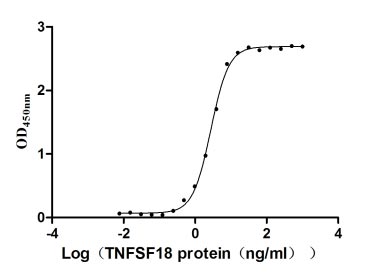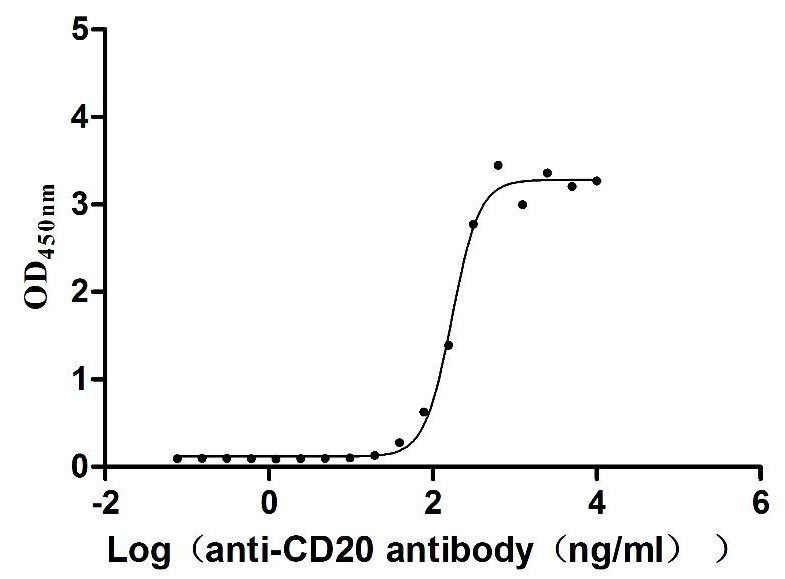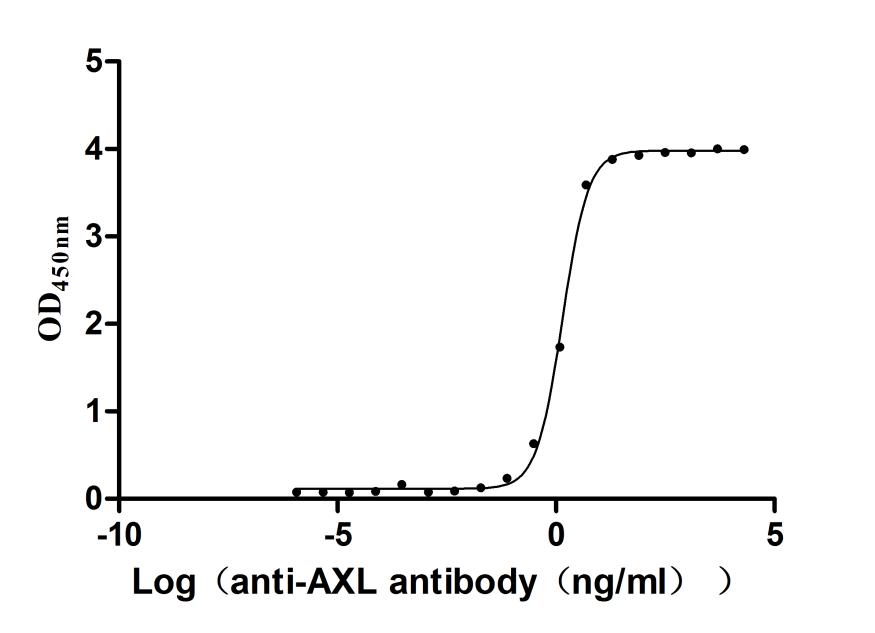Recombinant Human Frizzled-1 (FZD1), partial
-
货号:CSB-YP891570HU1
-
规格:
-
来源:Yeast
-
其他:
-
货号:CSB-EP891570HU1
-
规格:
-
来源:E.coli
-
其他:
-
货号:CSB-EP891570HU1-B
-
规格:
-
来源:E.coli
-
共轭:Avi-tag Biotinylated
E. coli biotin ligase (BirA) is highly specific in covalently attaching biotin to the 15 amino acid AviTag peptide. This recombinant protein was biotinylated in vivo by AviTag-BirA technology, which method is BriA catalyzes amide linkage between the biotin and the specific lysine of the AviTag.
-
其他:
-
货号:CSB-BP891570HU1
-
规格:
-
来源:Baculovirus
-
其他:
-
货号:CSB-MP891570HU1
-
规格:
-
来源:Mammalian cell
-
其他:
产品详情
-
纯度:>85% (SDS-PAGE)
-
基因名:
-
Uniprot No.:
-
别名:FZD1; Frizzled-1; Fz-1; hFz1; FzE1
-
种属:Homo sapiens (Human)
-
蛋白长度:Partial
-
蛋白标签:Tag type will be determined during the manufacturing process.
The tag type will be determined during production process. If you have specified tag type, please tell us and we will develop the specified tag preferentially. -
产品提供形式:Lyophilized powder
Note: We will preferentially ship the format that we have in stock, however, if you have any special requirement for the format, please remark your requirement when placing the order, we will prepare according to your demand. -
复溶:We recommend that this vial be briefly centrifuged prior to opening to bring the contents to the bottom. Please reconstitute protein in deionized sterile water to a concentration of 0.1-1.0 mg/mL.We recommend to add 5-50% of glycerol (final concentration) and aliquot for long-term storage at -20℃/-80℃. Our default final concentration of glycerol is 50%. Customers could use it as reference.
-
储存条件:Store at -20°C/-80°C upon receipt, aliquoting is necessary for mutiple use. Avoid repeated freeze-thaw cycles.
-
保质期:The shelf life is related to many factors, storage state, buffer ingredients, storage temperature and the stability of the protein itself.
Generally, the shelf life of liquid form is 6 months at -20°C/-80°C. The shelf life of lyophilized form is 12 months at -20°C/-80°C. -
货期:Delivery time may differ from different purchasing way or location, please kindly consult your local distributors for specific delivery time.Note: All of our proteins are default shipped with normal blue ice packs, if you request to ship with dry ice, please communicate with us in advance and extra fees will be charged.
-
注意事项:Repeated freezing and thawing is not recommended. Store working aliquots at 4°C for up to one week.
-
Datasheet :Please contact us to get it.
相关产品
靶点详情
-
功能:Receptor for Wnt proteins. Activated by WNT3A, WNT3, WNT1 and to a lesser extent WNT2, but apparently not by WNT4, WNT5A, WNT5B, WNT6, WNT7A or WNT7B. Contradictory results showing activation by WNT7B have been described for mouse. Functions in the canonical Wnt/beta-catenin signaling pathway. The canonical Wnt/beta-catenin signaling pathway leads to the activation of disheveled proteins, inhibition of GSK-3 kinase, nuclear accumulation of beta-catenin and activation of Wnt target genes. A second signaling pathway involving PKC and calcium fluxes has been seen for some family members, but it is not yet clear if it represents a distinct pathway or if it can be integrated in the canonical pathway, as PKC seems to be required for Wnt-mediated inactivation of GSK-3 kinase. Both pathways seem to involve interactions with G-proteins. May be involved in transduction and intercellular transmission of polarity information during tissue morphogenesis and/or in differentiated tissues (Probable).; (Microbial infection) Acts as a receptor for C.difficile toxin TcdB in the colonic epithelium.
-
基因功能参考文献:
- FZD1 and CAIX might be important biological markers for the carcinogenesis, metastasis, invasion, and prognosis of pancreatic ductal adenocarcinoma PMID: 28921449
- aken together, our results suggest that Sp1 plays a role in human osteoblast differentiation and mineralization, which is at least partially mediated by Sp1-dependent transactivation of FZD1. PMID: 27695039
- The amplification of miR-135b suppressed non-small cell lung cancer chemoresistance by directly mediating FZD1 down-regulation. PMID: 27643554
- FZD1 expression was down-regulated by AP2 expression and mediated osteoblast differentiation and mineralization. PMID: 25369469
- our data demonstrate that FZD1 regulates PKCdelta, and the PKCdelta/AP-1 signalling transduction pathway plays an important role in drug resistance in MES-SA/Dx5 cells. PMID: 24814288
- Polymorphisms in several genes involved in the Wnt signaling pathway were associated with hepatic fibrosis or inflammation risk in HCV-infected males. PMID: 24386373
- ACE2 and FZD1 are prognosis markers in squamous cell/adenosquamous carcinoma and adenocarcinoma of gallbladder. PMID: 23921915
- Experiments demonstrate a role of E2F1 in osteoblast differentiation and mineralization and suggest that FZD1 is required, in part, for E2F1 regulation of osteoblast mineralization. PMID: 23806799
- Fz1 is a Wnt responsive gene in colon-derived tissues. Fz1 expression exhibited increased expression in normal mucosa only in close proximity to colon cancer PMID: 23442549
- FZD1 appears to mediate multidrug resistance by regulating the Wnt/beta-catenin pathway PMID: 22484497
- Soluble FZC18 and Wnt3a physically interact in a cell-free system and soluble FZC18 binds the frizzled 1 and 8 receptors. PMID: 22303445
- These results suggest that FZD1 expression is regulated in a haplotype-dependent manner in osteoblasts and that these same haplotypes may be associated with biomechanical indices of bone strength. PMID: 20051274
- Fz1 and LRP1 bind, which disrupts the receptor/coreceptor complex formation and leads to the repression of the canonical Wnt signaling PMID: 14739301
- subcellular Fz localization, through the association with other membrane proteins, is a critical aspect in regulating the signaling specificity within the Wnt/Fz signaling pathways PMID: 15252441
- Bone morphogenetic protein-2 modulates Wnt and frizzled expression and enhances the canonical pathway of Wnt signaling in normal keratinocytes PMID: 16442268
- Data demonstrate that Frizzled receptors can functionally replace mating factor receptors in yeast and offer an experimental system to study modulators of Frizzled receptors. PMID: 17895994
- a frizzled module in cell surface collagen 18 inhibits Wnt/beta-catenin signaling PMID: 18382662
- a cis-regulatory polymorphism in the FZD1 promoter region may have a functional role in determining bone structural geometry PMID: 18715140
- The proportion of frizzled-1 positive ovaries was lower in normal patients than in those with ovarian cancer or bening neoplasia PMID: 19148501
- FZD1 links epithelial/mesenchymal disruption to idiopathic pulmonary fibrosis. PMID: 17496152
显示更多
收起更多
-
亚细胞定位:Cell membrane; Multi-pass membrane protein.
-
蛋白家族:G-protein coupled receptor Fz/Smo family
-
组织特异性:Expressed in adult heart, placenta, lung, kidney, pancreas, prostate, and ovary and in fetal lung and kidney.
-
数据库链接:
HGNC: 4038
OMIM: 603408
KEGG: hsa:8321
STRING: 9606.ENSP00000287934
UniGene: Hs.94234
Most popular with customers
-
Recombinant Human Tumor necrosis factor ligand superfamily member 18 (TNFSF18), partial (Active)
Express system: Mammalian cell
Species: Homo sapiens (Human)
-
Recombinant Human Tumor necrosis factor ligand superfamily member 9 (TNFSF9), partial (Active)
Express system: Mammalian cell
Species: Homo sapiens (Human)
-
Recombinant Human Nectin-4 (NECTIN4), partial (Active)
Express system: Mammalian cell
Species: Homo sapiens (Human)
-
Recombinant Dog B-lymphocyte antigen CD20 (MS4A1)-VLPs (Active)
Express system: Mammalian cell
Species: Canis lupus familiaris (Dog) (Canis familiaris)
-
Recombinant Human Glucagon-like peptide 1 receptor (GLP1R), partial (Active)
Express system: Mammalian cell
Species: Homo sapiens (Human)
-
Recombinant Human Cadherin-6(CDH6),partial (Active)
Express system: Mammalian cell
Species: Homo sapiens (Human)
-
Recombinant Human Tumor necrosis factor ligand superfamily member 15(TNFSF15) (Active)
Express system: Mammalian cell
Species: Homo sapiens (Human)
-
Recombinant Human Tyrosine-protein kinase receptor UFO(AXL),partial (Active)
Express system: Mammalian cell
Species: Homo sapiens (Human)








-AC1.jpg)











